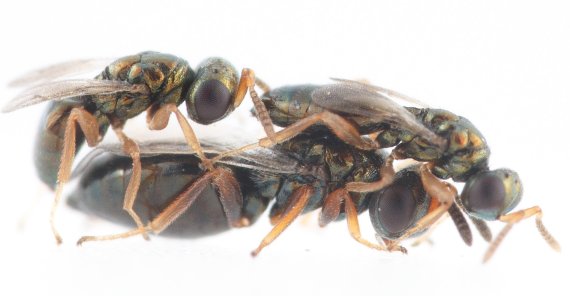Males of the Nasonia vitripennis try to mate with the female. The female has longer wings than the males. Her rear legs are brown, instead of yellow. © Jitte Groothuis
In her research, Verhulst studies three striking differences between parasitoid wasps of the genus Nasonia: the length of the wings, the colour of the legs and the palette of sex pheromones used by the wasp. Verhulst: ‘To be more precise: males have yellow legs and short wings, whereas the females have dark brown legs and long wings. And the sex pheromones they exude are also very different.’ She wants to know how these differences, which are relatively recent from an evolutionary point of view, have developed.
Doublesex
‘In other wasp genera, the difference in leg pigmentation is absent’, she continues. ‘And the significant difference in wing length is only present in a single species of Nasonia; the wings have equal lengths in the other species.’ There must be a genetic explanation for these differences. According to Verhulst, it is probably one that involves the doublesex gene, the gene that is responsible for the differences in development between the two sexes in insects.
It looks like a different [gene] management is causing the differences.
Eveline Verhulst
According to Verhulst, there are two alternative explanations for the emergence of the differences. ‘The doublesex gene itself changes, or it changes the management of the other genes. It looks like a different management is causing the differences. But we don’t really have a clue.’ Her research should shed some light on the matter. In the past years, Verhulst already worked on this gene with funding from a Veni grant – and a very different approach to the research.
General rules
Actually, the three properties mentioned do not have any particular significance in and of themselves. Verhulst: ‘I chose these properties because they are easily visible and therefore clearly discernible. Of course, I hope that from the results, I will be able to deduce a set of general rules regarding sexual differentiation.’ With the Vidi grant of 800,000 euros she received from NWO, Verhulst will have four years to find out.
Verhulst is one of 86 researchers to have received a Vidi grant. Three such grants went to WUR researchers. Besides Verhulst, these are philosopher Bernice Bovenkerk and chemist Maarten Smulders.

